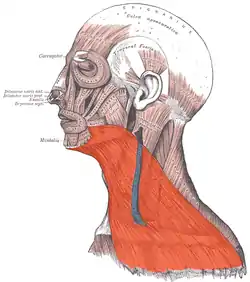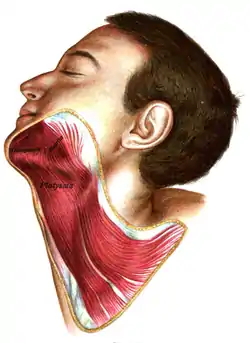頸闊肌
頸闊肌(Platysma)是頸部前側的淺層肌肉。它是一塊表面肌肉,主要覆蓋在胸鎖乳突肌表面。頸闊肌收縮時,會使頸部皮膚稍微起皺,產生「弓弦」(Bowstring)的效果。
| 頸闊肌 | |
|---|---|
 頸闊肌位於圖中橘色位置。 | |
 仔細移除頸部皮膚後,會露出頸闊肌。 | |
| 基本 | |
| 起點 | 鎖骨上下方的皮下組織 |
| 終點 | 下頷骨底部、臉頰皮膚、下脣皮膚、嘴角、口輪匝肌 |
| 动脉 | 頦下動脈與肩胛上動脈兩者的分支 |
| 神经 | 顏面神經頸支 |
| 相關動作 | (悲傷或驚嚇時)使嘴往下往外,使頸部皮膚往上緊貼牙齒 |
| 拮抗肌 | 嚼肌、顳肌 |
| 标识字符 | |
| 拉丁文 | Platysma |
| TA98 | A04.2.01.001 |
| TA2 | 2147 |
| FMA | FMA:45738 |
| 格雷氏 | p.387 |
| 《肌肉解剖学术语》 | |
結構
頸闊肌是一塊大片的扇形肌肉,肌肉纖維從蓋住胸大肌(Pectoralis major)與三角肌(Deltoid)上段的筋膜出發,構成扇形的寬端,接著肌肉向上越過鎖骨,沿著頸部邊緣向上向內側走,留下頸部中線下半段沒有被覆蓋。一些肌肉纖維在下頷聯合後下方會合,往後沿斜線(Oblique line)穿過下頷骨,其他肌肉纖維則附著在臉下方的皮膚與皮下組織上,或者與顴大肌、口輪匝肌等肌肉融合[1]。如果將嘴的外緣盡量向下拉,就會感受到頸部的頸闊肌拉緊。
血管
頸闊肌由頦下動脈與肩胛上動脈兩者的分支供應血液。
功能
起皺
頸闊肌整片運動時,頸部表面皮膚會產生斜向的皺紋,有如弓弦(bowstring)一般。[3]
下顎及下脣
頸闊肌前部(整塊肌肉最厚的部分)能夠使下顎向下降,並在蹙額撇嘴(frown)時把下脣與嘴角往下拉。平時頸闊肌的降下脣作用很小,該動作主要由降口角肌與降下脣肌負責。只有很少人能够有意识地操纵颈阔肌。皮肤松弛的老年人的颈部前部两侧可以看到两根沟,就是颈阔肌形成的。
臨床重要性
动物
在宠物中只有食肉目和猪有颈阔肌。这些动物的颈阔肌終點不在喉部,肌肉會向后一直延伸到肩膀。
食肉目还有两块下颌和胸之间的表皮肌肉。它们可以使得颈部下部的皮肤拉紧。
有蹄類没有颈阔肌。它们只有在颈部的背部有两块表皮肌肉。
參考資料
- Eibling, David E. . 1 2nd. Philadelphia: Saunders. 2008: 679 – 708. ISBN 978-1-4377-2083-9. OCLC 825780332. doi:10.1016/B978-1-4160-2445-3.50082-0 (英语).
- Anatomy & Physiology, 8th Edition, McGraw-Hill Co., 2008.
- Posnick, Jeffrey C. . . St. Louis: Saunders. 2014: 1746 – 1783. ISBN 978-1-4557-5027-6. OCLC 860861780. doi:10.1016/B978-1-4557-2698-1.00040-X (英语).
- Kim, Se-Hoon; Chang, Ung-Kyu; Kim, Daniel H.; Bilsky, Mark H., Kim, Daniel H.; Chang, Ung-Kyu; Kim, Se-Hoon; Bilsky, Mark H. , 编, , Tumors of the Spine (Philadelphia: W.B. Saunders), 2006-01-01: 378–394 [2021-01-06], ISBN 978-1-4160-3367-7, (原始内容存档于2022-02-06) (英语)
- Kim, Se-Hoon; Chang, Ung-Kyu; Kim, Daniel H.; Bilsky, Mark H. . . Philadelphia: Saunders. 2008: 378 – 394. ISBN 978-1-4377-2164-5. OCLC 489078564. doi:10.1016/B978-1-4160-3367-7.10019-7 (英语).
- Wolfe, Michael J.; Wilson, Keith. . . Philadelphia: Mosby. 2007: 329 – 357. ISBN 0-8151-4385-0. OCLC 608607674. doi:10.1016/B978-0-8151-4385-7.50027-8 (英语).
- Cothren, C. Clay; Moore, Ernest E. . 6th. Philadelphia: Mosby. 2009: 110 – 113. ISBN 0-323-07475-8. OCLC 460933202. doi:10.1016/B978-0-323-05711-0.00019-7 (英语).
- Bell, RB; Osborn, T; Dierks, EJ; Potter, BE; Long, WB. . J. Oral Maxillofac. Surg. 2007, 65 (4): 691–705. PMID 17368366. doi:10.1016/j.joms.2006.04.044.
- Labb??n a similar fashion to other muscles, the platysma is vulnerable to tears, strains and muscle atrophy among many other possible conditions. The platysma is vulnerable to neck injuries that may penetrate it. A type of medical imaging called CTA (computed tomography angiography), used to visualise arterial and venous vessels, is useful to minimise the number of neck explorations, thus improving the handling of the condition.[3] Another area of importance of the platysma lies in plastic surgery. Neck bands in the area become most noticeable with age, aggravated by weightlifting or facelift. If it doesn't heal with time, there are many options to correct this: Botox/Dysport/Xeomin and platysmaplasty. Platysmaplasty is a surgery in this area, that can be open or closed, in the latter a specialised instrument called plastymotome that allow the surgery to be done without incisions. It takes approximately 2 weeks for the symptoms to be reduced.[4], Daniel; Franco, R G.; Nicolas, J. . Plastic and Reconstructive Surgery. May 2006, 117 (6): 2001–2007. ISSN 0032-1052. doi:10.1097/01.prs.0000218972.75144.9c.
- Daher, JC. . Aesthetic Plast Surg. 2011, 35 (5): 866–77. PMC 3192284
 . PMID 21847680. doi:10.1007/s00266-011-9782-0.
. PMID 21847680. doi:10.1007/s00266-011-9782-0. - Alam, Murad; White, Lucile E. . . Philadelphia: Mosby. 2008: 1 – 18. ISBN 0-323-04546-4. OCLC 811786617. doi:10.1016/B978-0-323-04546-9.10001-9 (英语).
延伸閱讀
- David Burnie. . 台灣: 貓頭鷹出版社. 1997-06-30. ISBN 957-9684-11-1 (中文).
This article is issued from Wikipedia. The text is licensed under Creative Commons - Attribution - Sharealike. Additional terms may apply for the media files.